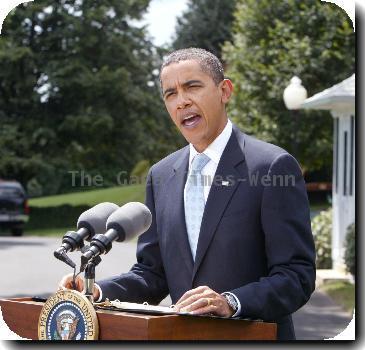BP says no signs that capped Gulf well has started leaking below ground
By APFriday, July 16, 2010
BP: No signs that capped Gulf well leaking
NEW ORLEANS — BP says there are no signs that its busted Gulf of Mexico well has started leaking underground more than a day after it was capped.
Kent Wells, a BP PLC vice president, said on a Friday evening conference call that engineers are closely monitoring pressure as well as the temperature and sounds around the well.
BP would immediately reopen the cap and let oil back into the Gulf if it sees signs of a leak lower on the well bore.
Wells said pressure readings suggest the reservoir deep underground that feeds the well may be depleting after the three-month spill.
Undersea robots are also scanning the sea floor near the well that was capped Thursday for the first time since the disastrous spill started in April.
THIS IS A BREAKING NEWS UPDATE. Check back soon for further information. AP’s earlier story is below.
NEW ORLEANS (AP) — In a nail-biting day across the Gulf Coast, engineers struggled to make sense of puzzling pressure readings from the bottom of the sea Friday, trying to determine whether BP’s capped oil well was holding tight or in danger of springing a new leak.
No immediate leaks were spotted, which was encouraging. But midway through the testing period on the new temporary cap that was bottling up the crude inside the well, the pressure readings were not rising as high as expected, said retired Coast Guard Adm. Thad Allen, the government’s point man on the crisis.
Allen said two possible reasons were being debated by scientists: The reservoir that is the source of the oil could be running low three months into the spill. Or there could be an undiscovered leak somewhere down in the well. Allen ordered further study but remained confident.
“This is generally good news,” he said. But he cautioned, “We need to be careful not to do any harm or create a situation that cannot be reversed.”
He said the testing would go on into the night, at which point BP may decide whether to reopen the cap and allow some oil to spill into the sea again.
Throughout the day, no one was declaring victory — or failure. President Barack Obama cautioned the public “not to get too far ahead of ourselves,” warning of the danger of new leaks “that could be even more catastrophic.”
Even if the cap passes the test, more uncertainties lie ahead: Where will the oil already spilled go? How long will it take to clean up the coast? What will happen to the region’s fishermen? And will life on the Gulf Coast ever be the same again?
“I’m happy the well is shut off, that there’s a light at the end of the tunnel,” said Tony Kennon, mayor of hard-hit Orange Beach, Ala. But “I’m watching people moving away, people losing their jobs, everything they’ve got. How can I be that happy when that’s happening to my neighbor?”
On Thursday, BP closed the vents on the new, tight-fitting cap and finally stopped crude from spewing into the Gulf of Mexico for the first time since the April 20 oil-rig explosion that killed 11 workers and unleashed the spill 5,000 feet down.
With the cap working like a giant cork to keep the oil inside the well, scientists kept watch on screens at sea and at BP’s Houston headquarters, in case the buildup of pressure underground caused new leaks in the well pipe and in the surrounding bedrock that could make the disaster even worse.
Pressure readings after 24 hours were about 6,700 pounds per square inch and rising slowly, Allen said, below the 7,500 psi that would clearly show the well was not leaking. He said pressure continued to rise between 2 and 10 psi per hour. A low pressure reading, or a falling one, could mean the oil is escaping.
But Allen he said a seismic probe of the surrounding sea floor found no sign of a leak in the ground.
Benton F. Baugh, president of Radoil Inc. in Houston and a National Academy of Engineering member who specializes in underwater oil operations, warned that the pressure readings could mean that an underground blowout could occur. He said the oil coming up the well may be leaking out underground and entering a geological pocket that might not be able to hold it.
But Roger N. Anderson, a professor of marine geology and geophysics at Columbia University, said the oil pressure might be rising slowly not because of a leak, but because of some kind of blockage in the well.
“If it’s rising slowly, that means the pipe’s integrity’s still there. It’s just getting around obstacles,” he said. He added that “any increase in pressure is good, not bad.”
The cap is designed to prevent oil from spilling into the Gulf, either by keeping it bottled up in the well, or by capturing it and piping it to ships on the surface. It is not yet clear which way the cap will be used if it passes the pressure test.
Either way, the cap is a temporary measure until a relief well can be completed and mud and cement can be pumped into the broken well deep underground to seal it more securely than the cap. The first of the two relief wells being drilled could be done by late July or August.
In a positive sign, work on the relief wells resumed Friday. The project had been suspended earlier this week for fear that the capping of the well could interfere with it.
There was no end in sight to the cleanup in the water and on shore. Somewhere between 94 million and 184 million gallons have spilled into the Gulf, according to government estimates.
In Orange Beach, Ala., long strands of white absorbent boom strung along the shore were stained chocolate brown after a fresh wave of BB-size tar balls washed up. Charter boat captains who can’t fish because of the spill patrolled the shore, looking for oil slicks. Fishing guides spent their time ferrying Coast Guard personnel. A flotilla of fishing boats operating as skimmers plied the waters across the Gulf.
Large sections of the Gulf Coast have been closed to fishing and shellfish harvesting. Many fishermen have been hired out by BP to do cleanup work.
Cade Thomas, a 38-year-old fishing guide from Pine, La., said the whole mentality of the place is different.
“It’s all changed dramatically. The fishing stories aren’t there,” he said. “There’s no stories to tell except where we went to today and how much oil we saw.”
In Grand Isle, La., most of the summer rental cottages are vacant, tables at the single high-end seafood restaurant are empty, and souvenir shops are barely doing enough business to pay the bills. A hand-painted sign along the main road rechristens the tourist town “Grand Oil.”
Folks are grateful the gusher has been stopped, but many say it is too late to save this summer. Thousands of tourists have gone elsewhere.
Scientists cannot say for certain what the long-term environmental effect will be. But long after the well is finally plugged, oil could still be washing up in marshes and on beaches as tar balls or patties.
There is also fear that months from now, those tar balls could move west to Corpus Christi, Texas, or travel up and around Florida to Miami or North Carolina’s Outer Banks.
Tim Kerner, mayor of Lafitte, La., said the crisis isn’t over by a long shot.
“There’s millions and millions of gallons of oil out there, and they need to keep the fishermen working,” he said. “We need to constantly have that boom up absorbing oil along the banks and hard boom in the bayous to protect the marshland. It’s no time to pull back. It’s time to continue to fight until we know it’s over.”
Kerner added: “I don’t want everybody to think we won this battle. This battle’s going to be ongoing for a while.”
Weber reported from Houston, Mohr from Venice, La. and Smith from Grand Isle, La. Associated Press Writers Colleen Long, Shelia Byrd, Jay Reeves, Matt Sendesky, Kevin McGill, and Ramit Plushnick-Masti contributed to this report.
Tags: Accidents, Barack Obama, Coastlines And Beaches, Environmental Concerns, Houston, Louisiana, New Orleans, North America, Texas, United States

